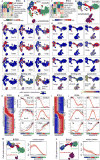Multipotent peripheral glial cells generate neuroendocrine cells of the adrenal medulla
- PMID: 28684471
- PMCID: PMC6013038
- DOI: 10.1126/science.aal3753
Multipotent peripheral glial cells generate neuroendocrine cells of the adrenal medulla
Abstract
Adrenaline is a fundamental circulating hormone for bodily responses to internal and external stressors. Chromaffin cells of the adrenal medulla (AM) represent the main neuroendocrine adrenergic component and are believed to differentiate from neural crest cells. We demonstrate that large numbers of chromaffin cells arise from peripheral glial stem cells, termed Schwann cell precursors (SCPs). SCPs migrate along the visceral motor nerve to the vicinity of the forming adrenal gland, where they detach from the nerve and form postsynaptic neuroendocrine chromaffin cells. An intricate molecular logic drives two sequential phases of gene expression, one unique for a distinct transient cellular state and another for cell type specification. Subsequently, these programs down-regulate SCP-gene and up-regulate chromaffin cell-gene networks. The AM forms through limited cell expansion and requires the recruitment of numerous SCPs. Thus, peripheral nerves serve as a stem cell niche for neuroendocrine system development.
Copyright © 2017, American Association for the Advancement of Science.
Figures






References
-
- Huber K, Kalcheim C, Unsicker K. The development of the chromaffin cell lineage from the neural crest. Auton Neurosci. 2009;151:10–16. - PubMed
-
- Saito D, Takase Y, Murai H, Takahashi Y. The dorsal aorta initiates a molecular cascade that instructs sympatho-adrenal specification. Science. 2012;336:1578–1581. - PubMed
-
- Ernsberger U, et al. Expression of neuronal markers suggests heterogeneity of chick sympathoadrenal cells prior to invasion of the adrenal anlagen. Cell Tissue Res. 2005;319:1–13. - PubMed
-
- Gut P, et al. Lack of an adrenal cortex in Sf1 mutant mice is compatible with the generation and differentiation of chromaffin cells. Development. 2005;132:4611–4619. - PubMed
Publication types
MeSH terms
Substances
Grants and funding
LinkOut - more resources
Full Text Sources
Other Literature Sources
Medical
Molecular Biology Databases

